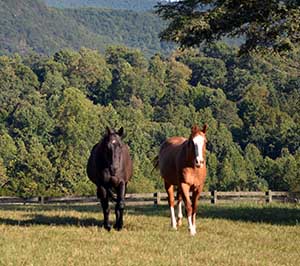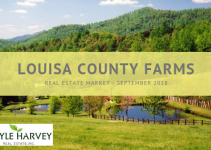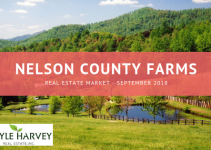Horse Health Care: Considerations when Buying a Horse Farm in Virginia
 We can etch idyllic images into the stone tablets of our minds, of the beautiful sprawling horse farms in Virginia, with proud Arabians and Thoroughbreds charging the lush green landscape. If you have always dreamed of owning a horse farm, central Virginia can hardly be beat. You certainly wouldn’t be the first person to put this together; there is a general spirit of equine appreciation with numerous foxhunts, trail riding clubs, training facilities scattered throughout the greater Charlottesville area.
We can etch idyllic images into the stone tablets of our minds, of the beautiful sprawling horse farms in Virginia, with proud Arabians and Thoroughbreds charging the lush green landscape. If you have always dreamed of owning a horse farm, central Virginia can hardly be beat. You certainly wouldn’t be the first person to put this together; there is a general spirit of equine appreciation with numerous foxhunts, trail riding clubs, training facilities scattered throughout the greater Charlottesville area.
In our haste to manifest these splendorous visions, we must not forget the day-to-day considerations through which good horse farms are made and maintained. We don’t mean to lecture you from our high horses (yikes), but good equine healthcare is important and can sometimes be overlooked by inexperienced newcomers or farmers who want to save a few bucks. Here we’ll outline some important things to keep in mind.
Lodging
Good health starts at home, no matter the species. Keeping horses on open pastures is the most common way to establish healthy practices. If you’re raising horses in central Virginia, there should be no shortage of open pasture to house your friends. Keeping horses out at pasture is linked to fewer behavioral problems and actual diseases, compared to stabling horses in stalls and such. This may be the guiding principle behind recess. It’s ideal (both for horse health and and pasture integrity) to have two acres per horse if you can manage it. Sometimes you’ll need additional acreage, if there are questions of soil quality, topography, or if you’ve got other animals using the property. The higher the stocking rates (# of horses on your property), the more pasture management you should be prepared to oversee. This entails mowing, fertilizing, and everything in between. Your horses should of course have access to clean drinking water wherever they are. For fencing, wood or diamond mesh are recommended. There is no one optimal fencing material; it depends on the age and disposition of your horses. But one universal consideration: make sure your gates fasten securely. Avoid gates/mesh with gaps big enough for horses to get their hooves stuck.
Of course you can’t just buy and maintain a plot of land and call it a day. Horses need solid shelters during inclement weather and for protection from the extreme cold and heat. If you’re new to the area, you should know that owning a horse farm in Charlottesville (or more likely the Greater Charlottesville area) means you should be prepared for rain, and lots of it. We aren’t very susceptible to hurricanes here (with a few exceptions), but sometimes we can get hit by severe rain from tropical cyclones and other inclement weather systems. Your shelter could be natural or man-made. Either way, we recommend between 100 and 150 square feet per horse. If you’re building shelters for your horses, you should optimize the drainage system and face the structure away from the prevailing winds. Proper ventilation is also vital. Try to make sure the structure is at least 50 feet from any property lines and 100 feet away from your neighbors.
If for some reason pasture is not a viable option, look into a drylot. There’s barely any vegetation on these; they tend to be used when pasture is unavailable. Make sure the drainage systems are highly functional, so as to avoid having horses standing around in the mud. Drylots are constructed with a stone base and covered with pulverized stone or clay. If you’re trying to manage obesity in horses, drylots are good because the horses can still walk around and expend energy, but they don’t have the option of idly grazing.
Stables should only be used in cases of extremely limited pasture, inclement weather, health issues or injury. Barns should be located close to turnout areas and in an area where you can easily turn around horse trailers and larger trucks. Optimize drainage and ventilation as best you can and make sure there are no gaps where horses may get a hoof stuck.
Diet and nutrition
Horses need the right balance of energy, protein, vitamins and minerals, and the proportion depends on your horse’s age, weight, and status (not marital…gestating, lactating, etc). With regards to evolution, horses came up grazing for several hours on sparse forage. They have small stomachs (2-5 gallons) and high metabolisms; as a result, they’re best suited to eating small amounts of food continuously. This makes pasture the ideal situation, and especially on central Virginia horse farms, where many horses are bred for recreation, pasture is often sufficient. If you don’t have access to pasture, feeding hay isn’t bad. General recommendations are between one-and-half and two pounds of hay per 100 pounds of body weight daily (at the very least). Horses are used to eating small amounts several times a day, so remember to split up the feedings. This will help with digestion and weight control. See our previous article about gauging weight.
Horses need salt to balance their diets; table salt (NaCl) contains both sodium and chloride, two important electrolytes. Even non-working horses need at least 10 grams a day. Working horses may need twice that. Electrolytes are important when it’s humid and horses are sweating or when it’s cold and horses aren’t drinking as much water. The pastures on many Virginia horse farms quite often have some level of electrolytes, but you should have salt for horses on hand, especially for those on a hay diet. If sodium is low, the cells are unable to hold water. This exacerbates conditions like anhidrosis (an abnormal lack of sweat in heat), and causes muscles to tense, stiffen, and tremble during use. Before starting any type of supplements though, always consult with your veterinarian.
As previously stated, horses have limited intake capacity. Pregnant mares, hard-working horses, and growing young foals may require grain to supplement their diets. Whether your horses graze pasture or eat hay, it may not be enough to sustain horses in these conditions. Manufacturer recommendations are based on body condition and exercise.
The amount of protein horses can synthesize depends on what amino acids are available. Lysine is usually depleted first, and so you’ll often see feed with “added lysine.” The average horse on a horse farm in central Virginia probably needs between 8-12% protein in its diet, 12-18% if it’s a young growing foal or a pregnant mare. Proteins go toward building muscles and hooves, and they are associated with rapid cell development, so it makes sense for these two groups of horses.
Vitamins can be important supplements, but horses synthesize a lot of their own so they may not be necessary in large amounts. Be wary of overdoing it here: water-soluble vitamins get excreted in the urine, but an excess of fat-soluble vitamins can contribute to obesity.
Minerals are inorganic materials. The amount of vitamins and minerals depends on age and status. Most commercial feed meets these needs, as does forage. Biotin, zinc, and copper can improve horse strength. But don’t overdo it. As always, talk with your vet first to create a nutrition plan that is suitable for each of your horses.
Contagious diseases and parasites
Horses are susceptible to many specific types of disease, especially pregnant mares, aging horses, and young foals. Any type of control program should reduce a horse’s exposure to disease-causing agents. One especially notable disease is equine infectious anemia (EIA) also known as swamp fever. It’s caused by a retrovirus and transmitted by blood-sucking insects such as the horse-fly. It’s also transmitted by reusing syringes and needles and symptoms include high fever, anemia, general weakness and fatigue, and swelling of lower abdomen and hind legs. It’s a serious affliction, capable of inducing miscarriage in pregnant mares. Make sure all new horses have a negative Coggins test…this ensures that they don’t have EIA. As a general rule, new horses should be reared in an isolation barn for 30 days. It may seem harsh, but it’s one of the only ways to protect your current stock from any unwanted diseases of which you may be unaware. Isolate for ten days, horses that seem sick, until symptoms disappear. Make sure you rigorously clean and disinfect all stalls where sick horses have been.
Proper contagious disease control also includes the use of vaccines. Ask your veterinarian about these, since they vary based on the age and status of your horse. Every adult horse needs vaccines for tetanus, rabies, west Nile virus, and eastern/western encephalomyelitis.
Generally all equestrian events such as horse shows, fox hunts and group trail rides will request proof that your horse has been vaccinated for the flu and equine herpes virus 1 and 4. Once again, talk to your vet about specific recommendations.
Parasites are just as much a legitimate a concern as disease in horses. Worms slip by without much notice until they are truly entrenched in a horse’s bodily systems, and by the time symptoms manifest themselves, they’re much more difficult to address. The most common are roundworms, strongyles, tapeworms, and botfly larvae. Young horses are more susceptible to worms. Parasite eggs are passed in the feces of infected horses and absorbed by other horses through the environment. The passage of parasite larvae through a horse’s body causes tissue damage in the lungs, intestinal walls, and blood vessels. When the worms mature, they cause intestinal irritation and obstructions. Talk to your vet if this happens; chances are you need a combination of anthelmintics (dewormer) and improved management practices. What type and how much dewormer to use depends on your horse’s weight, age and other factors. As far as management practices go, it’s all about proper handling of feces, as unpleasant as it sounds. Make sure you clean feces from stalls regularly, and avoid spreading manure until properly composted.
Hoof and dental
A horse definitely needs his hooves in order to be of much use, so it’s important to pay attention. Good hoof care will help guard against lameness, imbalance, and other problems. If you handle a horse’s feet early on, they’ll get used to it. Horses should have their hooves trimmed by a farrier every six to 12 weeks; this is key for balance. Also be on the lookout for sharp objects than can harm hooves, or small gaps where a horse could get a foot stuck easily. Horseshoes usually aren’t necessary unless you are ride a lot or ride on rough surfaces. Failure to maintain hooves could result in thrush (a bacterial infection) and cracks in the hoof.
Horses need proper dental care as well, and that means regular dental checkups. The better their dental condition, the more likely it is that a horse will keep its teeth, and that they’ll eat better and more efficiently. Horses don’t exhibit signs of dental wear until it’s too late, so it’s important to be proactive and preventative here. Some of the problems associated with the horse’s dental condition include sharp points that cause lacerations in the cheeks and jaw and improper tooth alignment, which can lead to uneven, worn down, fractured or missing teeth. As with hoof care, if you introduce a foal to dental care early, they’ll become used to it. Teeth should be examined after birth and again after weaning; it’s around the weaning stage that you’ll be able to identify any dental birth defects. So there you have it…our guide to making sure your horses stay healthy.
If you are searching for horse farms for sale in Virginia, let one of our experienced horse farm Realtors be your guide. In the meantime, you might like conducting your own search at www.CharlottesvilleHorseFarm.com.

